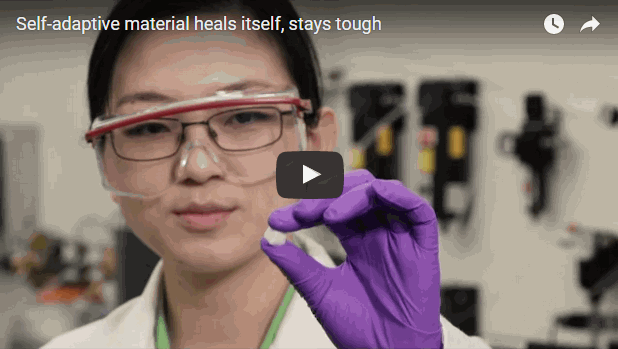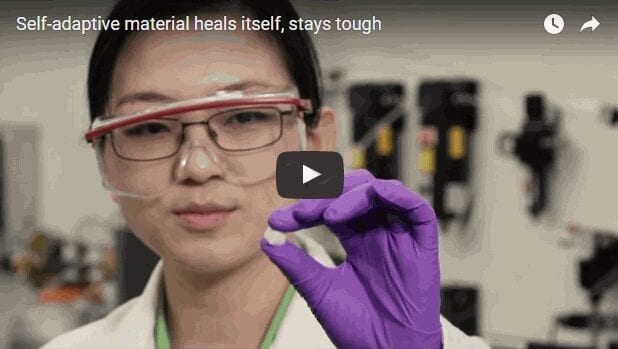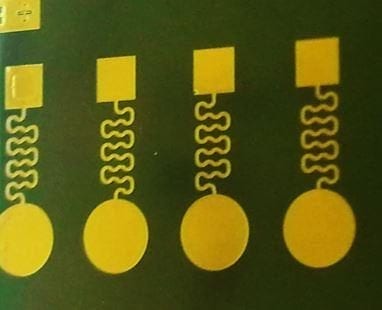
An adaptive material invented at Rice University combines self-healing and reversible self-stiffening properties.
The Rice material called SAC (for self-adaptive composite) consists of what amounts to sticky, micron-scale rubber balls that form a solid matrix. The researchers made SAC by mixing two polymers and a solvent that evaporates when heated, leaving a porous mass of gooey spheres. When cracked, the matrix quickly heals, over and over. And like a sponge, it returns to its original form after compression.
The labs of Rice materials scientists Pulickel Ajayan and Jun Lou led the study that appears in the American Chemical Society journal ACS Applied Materials and Interfaces. They suggested SAC may be a useful biocompatible material for tissue engineering or a lightweight, defect-tolerant structural component.
Other “self-healing” materials encapsulate liquid in solid shells that leak their healing contents when cracked. “Those are very cool, but we wanted to introduce more flexibility,” said Pei Dong, a postdoctoral researcher who co-led the study with Rice graduate student Alin Cristian Chipara. “We wanted a biomimetic material that could change itself, or its inner structure, to adapt to external stimulation and thought introducing more liquid would be a way. But we wanted the liquid to be stable instead of flowing everywhere.”
In SAC, tiny spheres of polyvinylidene fluoride (PVDF) encapsulate much of the liquid. The viscous polydimethylsiloxane (PDMS) further coats the entire surface. The spheres are extremely resilient, Lou said, as their thin shells deform easily. Their liquid contents enhance their viscoelasticity, a measure of their ability to absorb the strain and return to their original state, while the coatings keep the spheres together. The spheres also have the freedom to slide past each other when compressed, but remain attached.
“The sample doesn’t give you the impression that it contains any liquid,” Lou said. “That’s very different from a gel. This is not really squishy; it’s more like a sugar cube that you can compress quite a lot. The nice thing is that it recovers.”
Ajayan said making SAC is simple, and the process can be tuned – a little more liquid or a little more solid — to regulate the product’s mechanical behavior.
“Gels have lots of liquid encapsulated in solids, but they’re too much on the very soft side,” he said. “We wanted something that was mechanically robust as well. What we ended up with is probably an extreme gel in which the liquid phase is only 50 percent or so.”
Read more: Self-adaptive material heals itself, stays tough
The Latest on: Self-adaptive material
[google_news title=”” keyword=”self-adaptive material” num_posts=”10″ blurb_length=”0″ show_thumb=”left”]
via Google News
The Latest on: Self-adaptive material
- 6 Best CIA Review Courseson May 2, 2024 at 5:29 pm
Explore top choices and find the best CIA review course tailored to optimize your exam success. Get exclusive discounts here and save today!
- Atlanta Adaptive Re-Use & Repositioning Conferenceon April 24, 2024 at 5:00 pm
A model of adaptive reuse development, the 929 building is a refurbished warehouse building that was previously part of the West End’s “Warehouse Row” of food distributors. Providing ...
- Which Office Buildings Are Strong Candidates for Adaptive Reuse?on April 23, 2024 at 6:06 am
With office occupancy still well below pre-pandemic levels due to the prevalence of the hybrid work model and companies downsizing their space needs, property owners are resorting to creative ...
- The Echo Show 8 is the best smart display and speaker combo and it's only $105on April 17, 2024 at 8:43 am
Amazon's third-generation Echo Show features faster speeds and an ambient-powered display to streamline your smart home experience at 30% off with this limited time deal.
- Advances in adaptive, intelligent life-inspired materialson April 7, 2024 at 5:00 pm
Adaptive materials that can dynamically interact with their environment and make autonomous decisions could revolutionize fields such as medical implants, where devices could learn and adapt to ...
- Coacervation in systems chemistryon March 30, 2024 at 5:01 pm
Nature provides spectacular examples of molecularly-fuelled motion, chemical communication, quorum sensing, adaptive materials, oscillating reactions, and self-replicating systems, among others.
- adaptive technologyon February 8, 2024 at 3:59 pm
The area where these two disciplines overlap is called biomedical engineering (BME), and it’s a field that’s seeing fantastic growth thanks to advances in 3D printing, materials science ...
- Bio-inspired active and adaptive materialson February 3, 2023 at 8:56 pm
The guided debates focus on highlighting the main concepts of materials science that are required to critically evaluate the strong and weak points of the selected scientific paper. In our opinion, it ...
- New Adaptive Material Inspired by Tears (IMAGE)on July 30, 2022 at 4:47 pm
This is the design of the liquid-infused dynamic material. The bottom two photographs show the dry and lubricated elastic substrates (transparent when at rest). Disclaimer: AAAS and EurekAlert!
via Bing News











